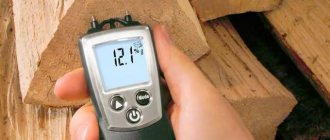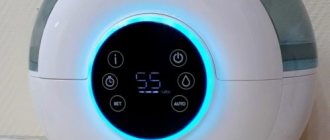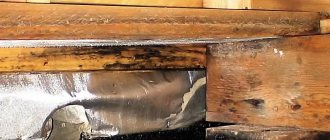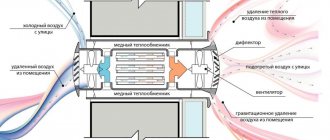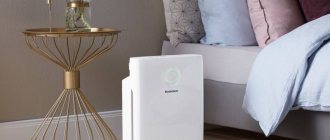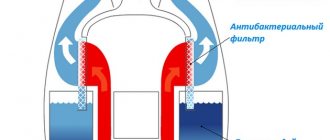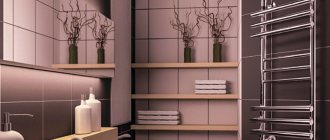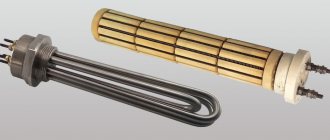Relative humidity is measured in a room - a value indicating the moisture saturation in the atmosphere. To find out the humidity in the house, you need to calculate the percentage of the maximum capacity and the actual amount of moisture. In everyday life, all complex calculations are done in a matter of seconds by special devices.
For interior design, you can use a composite board, as it does not deteriorate in any microclimate. This material consists of wood and polymers; thanks to this composition, this board is widely used in the interior: for terraces, the area around the pool, and interior decoration.
High or low humidity - what are the problems?
If we talk about humidity as a physical quantity, then this is the amount of water vapor present in a unit volume of a room. Usually 1 m³. It is clear that the volume of a room is the volume of air. That's why they talk about air humidity.
Scientists have divided this parameter into two types:
- Absolute humidity . This is the amount of water in a cubic meter of air mass.
- Humidity is relative . This is the ratio of the absolute value to the maximum possible moisture concentration inside the air at a given temperature. And this ratio of the two indicators is multiplied by 100.
So, when they talk about indoor air humidity - the norm, they mean a relative variety. It is the norm that determines the quality of living of people, the normal growth of house plants, as well as the long-term operation of household appliances, furniture and other household utensils. A large deviation from the norm in one direction or the other reduces the above-mentioned living conditions.
Absolute and relative humidity in the room Source tildacdn.com
For example, how dry air can affect a person:
- human moisture loss through the skin increases;
- accordingly, the elasticity of the skin, hair and nails decreases, and accordingly wrinkles appear, nails split, hair splits;
- the mucous membrane of the eyes dries out, causing symptoms such as “sand” in the eyes, itching, redness;
- the loss of water in the human body, or rather in the blood, leads to its thickening, hence headaches, heart rate increases, blood pressure increases, performance decreases, and weakness appears;
- digestion also slows down because the concentration of fluid inside the gastrointestinal tract decreases, which often leads to constipation;
- immunity decreases due to drying of the mucous membranes of the respiratory tract, which often leads to ARVI;
- The concentration of respiratory allergens in the air increases because they are bound by droplets of moisture if the indoor air humidity is normal.
Dry air is the cause of allergens Source chitazdrav.ru
As you can see, there are many problems with dry air in rooms. But this does not mean that increased humidity will create favorable living conditions. This also has its own problems, which are mainly associated with the appearance of microorganisms such as mold and fungi in the premises. Why are they dangerous:
- residents of such houses suffer from chronic respiratory diseases: allergies, runny nose, bronchitis, asthma;
- there is always a feeling of discomfort, especially humidity and stuffiness;
- the proliferation of microorganisms causes an unpleasant odor;
- Furniture deteriorates, washed clothes take a long time to dry, etc.
Protection of house structures from moisture
Even at the construction stage, it is necessary to ensure that the house is located on dry ground. Proper equipment of the building with a drainage system, regular checking of the condition of drains and gutters will guarantee the free and rapid outflow of water during rain, and will prevent the accumulation of moisture near the foundation.
A successful location of a residential building, proper operation of the drainage and water outflow system will ensure quick drying of wall panels and house structures. In order to increase the moisture resistance of laminated timber, it is best to treat the outer surfaces with moisture-proof compounds. Typically, these components are included in current paint and varnish materials, so painting the outside of a house will not only serve an aesthetic function, but also provide protection to house structures from moisture. Otherwise, the external elements of the structure will quickly darken, which will become an excuse for subsequent sanding of the laminated veneer lumber.
Translucent water-based paints not only preserve the structure and appearance of wooden structures, but also additionally increase the moisture resistance of laminated veneer lumber. Accordingly, treated structures are less susceptible to rotting, and there is less likelihood of mold and mildew forming in hard-to-reach places.
What affects humidity
In general, with humidity, or rather with the factors influencing it, the situation is paradoxical. Firstly, it completely depends on the air temperature. Purely according to physical laws, the higher the temperature, the more water can fit into the air. Because it increases in volume under the influence of rising temperatures.
What affects humidity Source 900igr.net
And everything would be so if the conversation was about an absolute indicator. And since we are talking about humidity inside the house, here, as mentioned above, the relative parameter is taken into account. And in this case, physical laws operate in reverse. That is, the higher the air temperature, the lower its humidity will be. This means relative. Because the volume of air has increased, but the amount of water in it has not changed.
What household appliances and objects affect relative humidity:
- heating devices: heating radiators, fireplaces, stoves and others;
- air conditioners;
- carpets, upholstered furniture, soft toys, curtains and more.
But the following devices lead to increased humidity inside the house:
- aquarium;
- leaking pipes;
- boiling kettles and pots;
- the roof, if it leaks somewhere;
- wet laundry hanging inside the house.
An aquarium in a house increases humidity Source yandex.net
See also: Catalog of companies that specialize in complex installation of internal engineering systems of a country house.
What to do to organize a suitable microclimate in residential premises
The main factor influencing humidity indicators is air temperature. If the room is warm, the air absorbs a lot of moisture. To maintain normal humidity, it is enough to remember that if the temperature is high, the volume of water in the air will be less. If the problem occurs in winter, it can easily be solved by ventilating the room. What can be used to absorb moisture:
- appliances used for heating;
- air conditioning systems;
- soft objects, carpet.
To maintain a normal level of moisture, an aquarium, glass or other containers filled with liquid, and hanging wet laundry will help.
Standards
Let's now figure out what humidity should be in the room. Everything will, of course, depend on the purpose of the room and the time of year. But there are regulations where normal humidity is indicated by certain values.
Eg:
- In the warm season, this figure varies in the range of 30-60%. There is such a thing as the maximum permissible norm. It is equal to 65%. In some regions, for example, maritime regions, 75% is considered the norm.
- In cold weather, the norm is 30-45%, the maximum is 60%.
Note! These indicators are only for residential premises and specifically for humans. In rooms such as corridors, hallways, toilets and bathrooms, and storage rooms, humidity is not standardized.
Also, do not forget that there are plants, furniture, household appliances, etc. in the house. For them, the standards are slightly different from the above:
- For plants – 40-70%, for tropical – 80-95%, for subtropical – 75-80%.
- Books are best stored at a humidity of 30-65%.
- Furniture and paintings are well preserved at 40-60%.
- The same goes for antiques.
- For technology, 45-60% is suitable.
Optimal humidity in the house Source ventilation-conditioning.ru
So, the optimal humidity in a room for a person is from 30 to 60%. But if children live in the house, then the standard in their rooms is slightly different. Here this figure should be in the range of 50-70%. Because children are more sensitive to various harmful bacteria, infections and other parasites. Plus, they have a higher intensity of heat exchange processes in the body. That is, they release moisture faster, due to which the fluid content in the body decreases. Therefore, doctors recommend that sick children stay in rooms where the humidity does not drop below 60%.
Attention! In the winter season, when the heating system is turned on in houses, the moisture content inside the rooms decreases sharply - by 15-20%. Therefore, if your family has children, as well as asthmatics and allergy sufferers, then this air parameter must be maintained artificially.
Heating appliances greatly reduce indoor humidity Source naimtruda.com
What should the normal parameter be?
Good climate conditions in the home are important for human life. A comfortable stay in a particular room completely depends on the appropriate level of moisture. Each living space has its own parameters for the required temperature and humidity, depending on its purpose. The main points for many are to ventilate the room and measure the ambient temperature and the condition of the living organisms living there.
The average data established by experts is 45%. It may vary depending on the purpose, size and type of room. Operating conditions are an important factor. Of course, small errors are possible both in winter and summer. If the humidity is high or low, some discomfort occurs. In addition to the health of the people living in the apartment, plants suffer, property is damaged, and fungus appears. Let's consider the normal parameters for different rooms:
- dining room – up to 50%;
- bedroom – up to 50%;
- children's room - up to 60%;
- kitchen and bathroom – 40 – 60%;
- library, study – up to 40%.
Of course, the bathroom and kitchen will be higher in terms of indicators, because the standard for them is higher.
Rules for measuring relative humidity
Having decided on the norm of humidity in the room, we will understand the methods for measuring it. The easiest and most accurate way is to use a hygrometer. In stores, this device is presented in a wide variety. And they differ from each other in the measurement method and operating principle. Namely:
- electrical;
- condensation;
- hair;
- chemical and others.
Psychrometric hygrometer, also known as psychrometer Source 900igr.net
Video description
In the video, a specialist talks about psychrometers and how they can be used to measure indoor air humidity:
There are other measurement options that can be classified as “folk”. The easiest one here is to use a glass of water. It is pre-cooled to +5 °C, for example, it can be placed in the refrigerator for several hours. And then they are placed in a room away from heating devices.
If the outer surfaces of the glass dry quickly, say in a few minutes, then the humidity in the room is greatly reduced. If there is evaporation left on them and it does not disappear, the humidity in the room is normal. If streams of water flow down the walls of the glass, then most likely the humidity in the room is high.
Foggy glass of cold water Source onegoodthingbyjillee.com
Features of moisturizing mechanisms
Modern models of humidification devices are presented in a wide range. The algorithm for their operation is simple - the liquid with which a special tank is filled evaporates, thus saturating the surrounding room. Let's consider three main types of units:
- standard or mechanical. Powered by a fan located inside the system. It drives air through a specially mounted container of water inside. Thus, dust and particles are removed and humidification occurs. There is a small drawback: the device is very noisy, and the level of possible humidification reaches only 65%;
- steam version: the work is done as in a boiling kettle, in which the water has boiled. All this comes out as steam. You can use water from the central water supply, so-called hard water. The equipment is quite noisy and uses a lot of electrical energy. It is important to use it very carefully - the steam produced by the unit is very hot. It can leave a burn, leave damage on nearby surfaces;
- ultrasonic: water turns into steam. This happens due to the operation of the membrane plate. Its undeniable advantage: it is silent during the working process. Heating the liquid kills microorganisms in the atmosphere. Important: the liquid is poured only purified. It is important to regularly change cartridges to normalize the operation of the entire structure.
It is recommended to select a humidifier according to the microclimate of the room.
Was this article useful to you?
How can you regulate humidity?
You need to choose methods of change depending on whether this parameter is high or low. Let's start with the first one, that is, high humidity. What can you offer:
- organize frequent ventilation;
- install dehumidifiers;
- install hoods;
- constantly monitor plumbing and heating, water supply and sewerage pipes so that they are in sealed and in good condition;
- use different types of heaters to heat the house;
- Do not dry laundry inside.
Now about how you can increase relative humidity:
- install an aquarium or a decorative fountain in one of the rooms;
- use air conditioners and heaters as little as possible;
- install sprinklers, also known as humidifiers, or do it with a hand sprayer;
- carry out wet cleaning more often;
- place wet towels on heating radiators;
- plant as many house plants as possible.
Enemies of air humidity
So, having dealt with the question of what humidity should be in a living room, we move on to household appliances, which greatly underestimate this parameter. Let's start with the fact that all electrical appliances heat up and produce heat. And accordingly, they heat the air temperature inside the house, reducing humidity.
Of particular note is the air conditioning, which everyone uses in the summer. Its operating principle is based on the fact that the device takes in humidity, condensing it on a heat exchanger located in the indoor unit. And this water is carried out into the street through a tray and a hose.
Here you need to add TVs, computers and other electrical appliances. But the most serious enemy of the humidity regime is the heating system of the house. In winter it can reduce this parameter to 20%, which is already considered a critical value.
Many people try to solve this problem by ventilation. But not many people know that there is little moisture in cold air. And if you let it into the room, it heats up, expands and becomes dry.
Interesting Facts
It is a well-known fact that fog means one hundred percent humidity. But this natural phenomenon is possible only at a temperature of 0 °C. If the fog is placed in a room with a temperature of +22 °C, then the humidity in such a room will become only 23%. This shows well how temperature changes humidity.
Dry air seems colder to us. And vice versa. It's all about our body, which produces sweat in hot weather. The latter is moisture, which performs the functions of thermoregulation of the body. That is, sweat makes our skin moist, thereby removing heat from its surface. The same thing happens in winter. Only in this case does dry air cool the skin. Therefore, this air seems colder to us.
Please note that an increase in temperature of just 2 °C entails a decrease in humidity by 25%. Therefore, you should not heat your home too much. Room temperature, namely +18-22 °C, is the optimal mode in which the humidity is also in ideal condition. That is, by adhering to these two parameters, you can save a lot of money on heating your home in winter.
How does a person feel at different air humidity Source v.5klass.net
What should be the normal indicators for children?
The physiology of a child is much more delicate than that of an adult. Children are more often exposed to diseases, respiratory colds, and may freeze or overheat. The temperature and humidity levels must be appropriate for the child’s room; it is necessary to create special conditions to protect the small organism from stress factors. Dry air in a child’s room is enemy No. 1. The air masses in the room must be humidified, because diseases of the baby’s mucous membranes can occur and problems with the immune system may arise. A common symptom is peeling and itching of the skin. The percentage of moisture in the microclimate of the children's recreation area should not exceed 50 - 60%. If a child has a cold, the moisture level needs to be increased - this is how the mucous membranes better cope with dryness.
The ratio of humidity in winter and summer in the room for the baby should be the same, but with one exception - the air temperature should be at least 24 degrees. If the indicators are higher, the nursery will turn into the tropics.
Briefly about the main thing
The optimal air humidity in residential premises is 30-60%. In children's rooms it is better to keep it at 70%. This also applies to rooms where asthmatics and allergy sufferers live.
The simplest device that measures indoor humidity is a psychrometric hygrometer, also known as a psychrometer.
It is useless to ventilate rooms in winter to increase humidity. Because there is little moisture in cold air. Once inside the house, it heats up, becoming dry, which helps reduce the humidity level.
The biggest enemy of humidity is the heating system of the house. But this indicator is also affected by all electrical household appliances.
To increase this indicator, it is recommended to install household humidifiers; fortunately, they are presented in a huge assortment in stores.
Ratings 0
